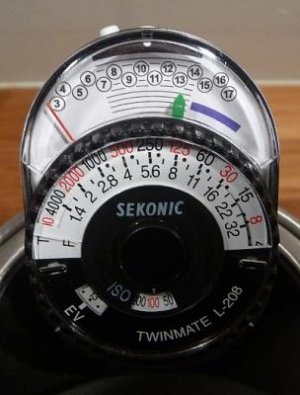froyd
Mentor
I have used a Gossen Sixtino for the past 5 or so years, small and very light. I just upgraded to a Sekonic Twinmate L-208, because it's a similar form factor with larger font. The Twinmate takes a battery, whereas every other light meter I own doesn't. I haven't used it yet. Here it is next to another new purchase.
View attachment 4825235
I find this modification to the L208 to be very helpful when taking pictures in varying light. It was created by Joakim Lare and posted publicly around 2011. I'm attaching the file here and take no credit for it. I hope Mr. Lare will not mind since he posted the file on several public forums previously.
Here is Mr. Lare's original post
The great advantage of this modification is that it allows the user to quickly determine how many stops light variation there are in a scene (say from the sunny side to the shadows) without referring to the EV window. It sounds like a small thing, but in practice it's great to quickly see that the light changed by to EVs so you just adjust rotate your aperture (or shutter) a couple of clicks and are good to go. Here is the original post from the creator of this Twinmate enhancement:
I'm sure there are many of you who like to measure once or twice during a session just to check that your guessing isn't way off, and most likely you're just interested in the current EV - the corresponding shutter/aperture combinations are easily adjusted in mind and on camera. So it would be nice if the meter would tell you the EV right away, without you having to do anything to find out.<br>
At least I want it that way, so I put some additional info on the background plate inside the Sekonic L-208. The new scale, that has EVs from 3 to 17 printed out, was designed digitally using CAD software and styled via vectors to resemble the original, then printed out at scale 1:1, (43.5mm wide). I put some double adhesive tape on the back, cut the contour away with a small pair of scissors and stuck it on the original plate. The meter is assembled with two screws and if you're careful with the delicate parts, it's an easy job.
Attachments
The Spastic Image
Established
This ad very well explains why I love my Gossen Luna-Pro F. I find my example to be consistently accurate, easy to use, and it's ability to meter a scene flexibly means I get better exposed film! Gossen took an already excellent light meter, and improved on it considerably Mine is rugged, well built, a joy to use, and love that German craftsmanship and precision approach!I have many meters - mostly vintage (in camera and out), but once I saw the Gossen Luna-Pro SBC featured prominently in Ansel Adams' "The Negative", I had to get one.
Has reflected and incident mode (sliding dome) and a spot meter attachment module (which I don't have) and other modules that plug into the top of the meter. Runs on a standard 9V square battery.
Very easy to operate (null metering) - press the RED button and 'null' the RED needle to 0 and read off the scale(s) below. Battery check built-in (green button/green BATT scale readout). Made in Germany. Robust build. Still have it.
I especially enjoyed using it in the 1980's when I had my Hasselblad kit as it was easy to transfer the meter EV reading to the CF lens EV ring.

-b.jpg)
largedrink
Down Under
Share:


